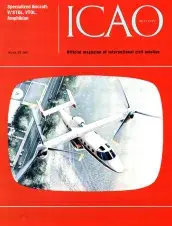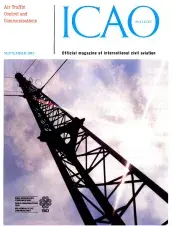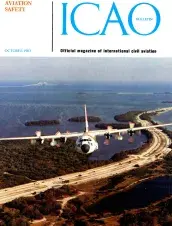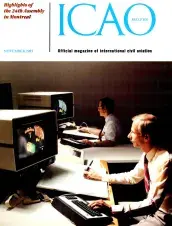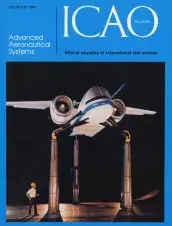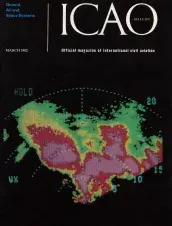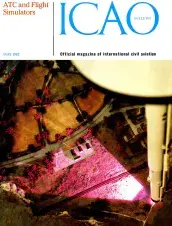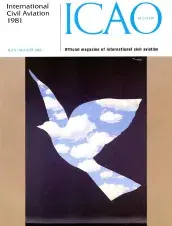国际民航组织期刊
The objective of the Journal is to provide a concise account of the activities of the International Civil Aviation Organization and to feature additional information of interest to Contracting States and the international aeronautical world.
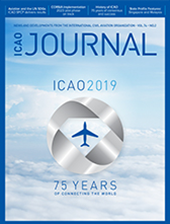 (ICAO Journal is available in English only from 2013)
(ICAO Journal is available in English only from 2013)
Studies are under way at Bell Helicopter Textron for possible development of a large tilt-rotor V/STOL aircraft. (Teamed with Boeing, the firm already is developing a large version of this V/STOL concept for military use.) The XV-15 prototype has demonstrated a cruise speed of over 550 km/h at an altitude of 16,000 feet. Thus, a large commercial version would be superior in many operating roles currently performed by more conventional helicopters and STOL aircraft, developers believe.
Wideband conical antennas such as this one are widely used in ground-air communications for omnidirectional HF transmission and reception. A special system using such an antenna was designed and installed recently at Shannon Aeradio, Ireland, by CSA (C&S Antennas Ltd.). This was, in part, for the NARTEL (North Atlantic Radio/Telephone) HF communication system used by aircraft on North Atlantic flight paths. Shannon Aeradio also comprises the communications centre for Scotland's Prestwick Airport.
Wideband conical antennas such as this one are widely used in ground-air communications for omnidirectional HF transmission and reception. A special system using such an antenna was designed and installed recently at Shannon Aeradio, Ireland, by CSA (C&S Antennas Ltd.). This was, in part, for the NARTEL (North Atlantic Radio/Telephone) HF communication system used by aircraft on North Atlantic flight paths. Shannon Aeradio also comprises the communications centre for Scotland's Prestwick Airport.
The way of the future? Shown are" interactive-graphics" technicians at Westinghouse's Baltimore facility employing computer-aided design to develop different concepts that might be applied to the new ASR-9 Airport Surveillance Radar now being developed. Award of the over US$480-million contract to the firm to develop and build the system -- the largest radar production contract ever let by the U.S. FAA -- was announced last month. In all, 137 of the ASR-9s will be delivered over a five-year period, beginning in 1986. (For technical details on this system, see the 1CAO Bulletin, September 1983, pages 37-40.)
The European Space Agency employed Ariane L04 to launch the Marecs-A special-purpose communication satellite into a geostationary orbit over the Atlantic Ocean on 20 December 1981. Marecs-A is leased to the International Maritime Satellite Organization (INMARSAT) to provide efficient long range telecommunications for shipping and off-shore industries. It could also be used for initial experimental use for aeronautical communications, before INMARSAT begins operations with its new series of space vehicles in 1988.
ASTRE, an airport surface detection and display system developed by Thomson-CSF, is shown as installed in the tower at Charles de Gaulle Airport. To provide the necessary panorama of the airport ground traffic scene, sophisticated digital processing is required. The presentation of this information in the control tower is based on direct conversion of the radar scan into a television scan.
Full-scale modal of a tilt-fan vertical / short take-off and landing (V/STOL) aircraft design is shown undergoing proof-of-principle testing in the Ames Research Center wind tunnel in California. Powered by two General Electric TF-34 high-bypass-ratio engines, aircraft vertical lift-off is achieved by rotating the turbofans to the vertical position. Control is achieved during this phase through use of computer-controlled moveable aerodynamic surfaces (vanes) immersed in the exhaust of the engines. Strakes, or longitudinal fences, are employed on the fuselage undersurface to make maximum use of ground effect and also to prevent the upwash of hot exhaust from being reingested by the engines, thus maintaining maximum thrust.
A fourth colour, magenta, has been introduced by Bendix Corp. into its RDR-1150 weather radar system to reveal severe storm areas within a contouring cell. Four levels of rain-rate discrimination are now employed — the traditional green, yellow and red plus magenta (set within the red) to show higher orders of rainfall rate. By helping the pilot to understand better the dynamics of severe weather conditions, he will be in a better position to make faster, safer storm-avoidance decisions. Another new feature is "weather attenuation compensation," which increases receiver detection sensitivity. Eight range presentations can be made from 5-320 NM (9-593 km).
First civil application of the Boeing 234, a derivative of the venerable Chinook helicopter, is by British Airways Helicopters, operating out of Aberdeen, Scotland, to support offshore oil operations in the North Sea. Shown is Shell Oil's Brent-D platform, one of four working in this particular field.
Link's Laser Image Generator visual system provides realistic scene detail at all altitudes. A multicoloured laser beam scans a model board within the pilot's field of view; the reflected light is detected by a bank of photomultipliers, which furnish high-resolution displays to the flight simulator.
